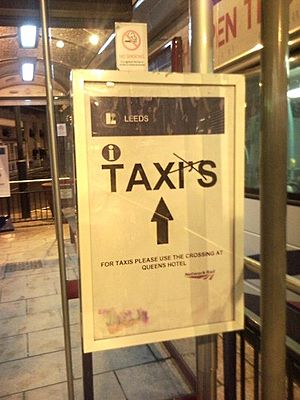Apostrophe facts for kids
Quick facts for kids ’ |
|||||||
|---|---|---|---|---|---|---|---|
|
Typographic apostrophe
|
|||||||
|
|||||||

The apostrophe (’) is a special mark used in writing. It helps us understand words better. Think of it as a small floating comma!
In English, the apostrophe has two main jobs:
- To show when one or more letters have been left out of a word. For example, do not becomes don't.
- To show that something belongs to someone or something. For example, the cat’s whiskers means the whiskers that belong to the cat.
Contents
How to Use Apostrophes
Its versus It's
One of the most common mistakes people make is confusing its and it's. Let's clear it up!
- Its means "belonging to it." It shows ownership, just like his or hers.
- The cat chased its tail. (The tail belongs to the cat.)
- The car lost its wheel. (The wheel belongs to the car.)
- It's is a shortened way of saying "it is" or "it has."
- It's cold outside. (This means "It is cold outside.")
- It's been a long day. (This means "It has been a long day.")
A good trick is to try replacing it's with "it is" or "it has." If it makes sense, then it's is correct. If it doesn't, you should use its.
This rule also applies to other words like yours, theirs, and ours. These words already show ownership, so they don't need an apostrophe.
- The book is yours.
- That idea was theirs.
Showing Ownership
Apostrophes are also used to show that something belongs to a person, animal, or thing.
- Mike's car: This means the car that belongs to Mike.
- The dog's ball: This means the ball that belongs to the dog.
What about when there's more than one owner?
- If the word is plural and ends in s, you put the apostrophe AFTER the s.
- The students' projects: This means the projects belonging to many students.
- If the word is plural but doesn't end in s (like children or men), you add ’s.
- The children's toys: This means the toys belonging to the children.
Apostrophes We Don't Need
Sometimes, people add apostrophes where they aren't needed, especially with plural words. Remember, if you're just talking about more than one of something, you usually don't need an apostrophe.
- Wrong: CD's or DVD's
- Correct: CDs (meaning many CDs)
- Wrong: Apple's (unless it means something belonging to an apple, like "the apple's core")
- Correct: Apples (meaning many apples)
The only time a plural word gets an apostrophe is when it's showing ownership, as explained above (e.g., the dogs' toys).
Shortening Words
Apostrophes are also used when letters are left out of words to make them shorter. This often happens in casual talk, songs, or older writings.
- Don't is short for do not.
- Can't is short for cannot.
- Go get 'em tiger! Here, ’em is short for them.
- Li'l Bow Bow is short for Little Bow Bow.
Images for kids
-
Sign to Green Craigs housing development
-
Apostrophes (green and red) and other similar marks (blue) shown in different fonts.
See also
 In Spanish: Apóstrofo para niños
In Spanish: Apóstrofo para niños



